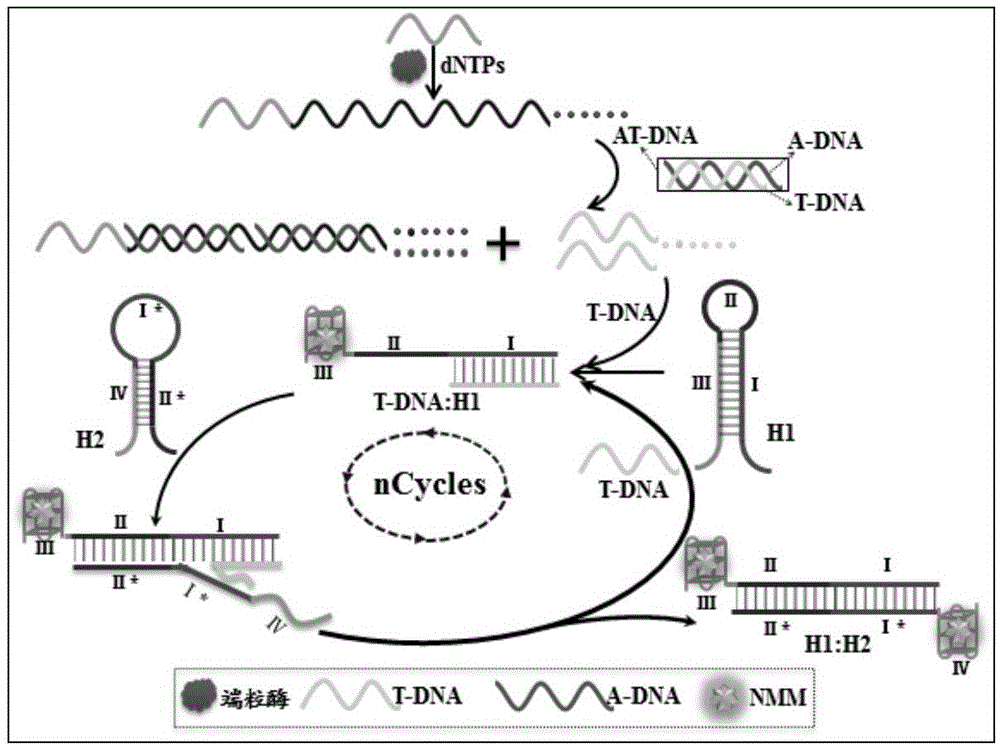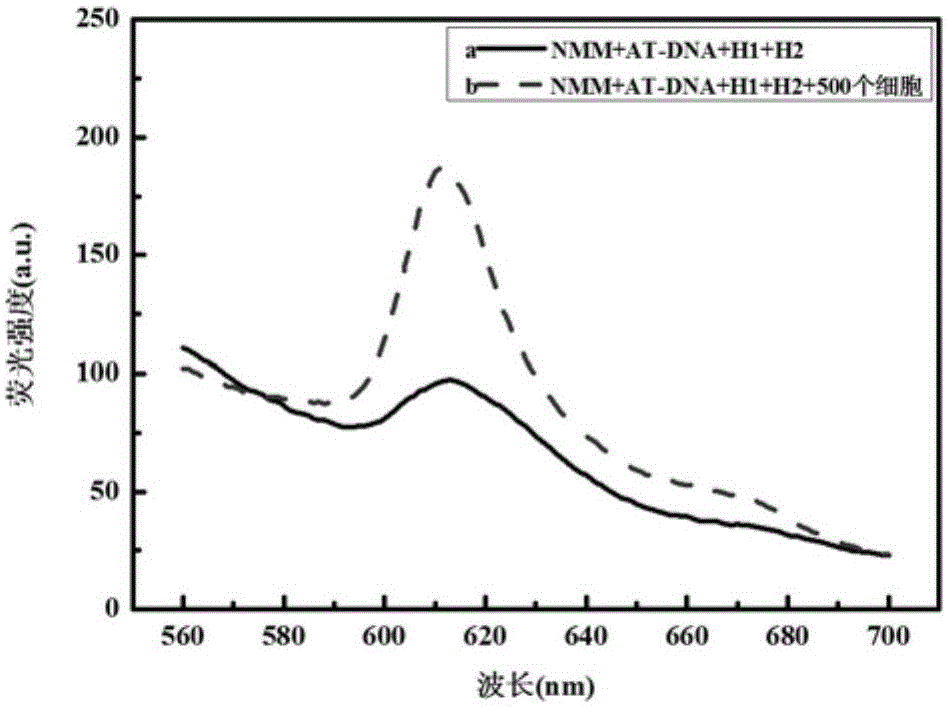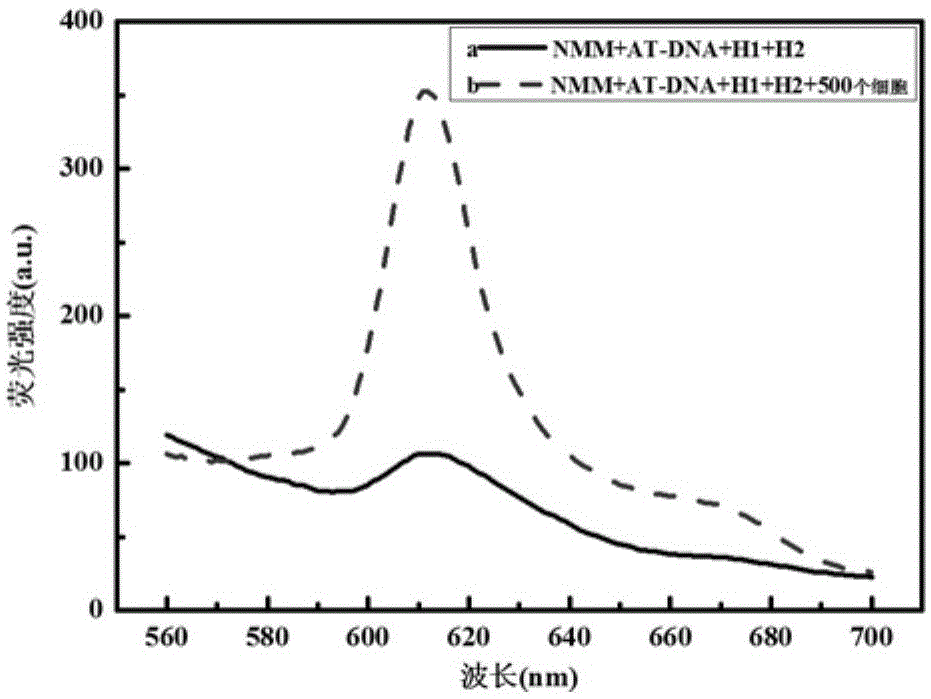Triple-amplification-technology-based homogeneous-phase label-free method for detecting activity of telomerase
A technology of telomerase and amplification, applied in the field of telomerase activity, can solve problems such as high cost, cumbersome steps, and complicated operation
- Summary
- Abstract
- Description
- Claims
- Application Information
AI Technical Summary
Problems solved by technology
Method used
Image
Examples
Embodiment 1
[0029] Taking the detection of telomerase in HeLa (HeLa) cells as an example, combining figure 1 It can be seen that the detection method of the present embodiment is realized by the following steps:
[0030] (1) According to the conventional method, lyse the raised HeLa cells to extract telomerase, add 0.4 μL of 10 μmol / L telomerase substrate TS (sequence: : AATCCGTCGAGCAGAGTT) and the telomerase extract corresponding to 500 HeLa cells were incubated at 37°C for 1 hour to obtain the test solution system.
[0031] (2) Use a concentration of 50mmol / L, pH=7.4 and contain 5mmol / LMgCl 2 Tris-hydrochloric acid buffer solution will hairpin DNA probe H1 (sequence 5'-GGGATGGGTTAGGGCGGGAATCAGAGGGCGGGATGGGGATTCCCGCCCTAACCCTAACTC-3'), hairpin DNA probe H2 (sequence 5'-GGGTTGGGCGGGATGGGGATTAGGGTTAGGGCGGGAATCCCCATCCCGCCCTCTGA-3') and single-stranded A -DNA (5'-AACCCTAACCCTAACCCTAACTCTGCTC-3') and single strand (T-DNA5'-GAGTTAGGGTTAGGGCGGGAATC) were diluted to a concentration of 20 μmol / L...
Embodiment 2
[0039] Taking the detection of telomerase in human acute lymphoblastic leukemia T lymphocytes (CCRF-CEM) as an example, the detection method of this embodiment is realized by the following steps:
[0040] (1) Lyse and extract telomerase from raised human acute lymphoblastic leukemia T lymphocytes (CCRF-CEM) according to conventional methods, and add 0.4 μL to 20 μL of telomerase repeat amplification buffer solution at a concentration of 10 μmol / L The telomerase substrate TS and the active telomerase extract corresponding to 500 human acute lymphoblastic leukemia T lymphocytes (CCRF-CEM) were incubated at 30° C. for 2 hours to obtain the test solution system.
[0041] (2) Tris-hydrochloric acid buffer solution (containing 5mmol / LMgCl) with a concentration of 50mmol / L and pH=7.4 2 ) with hairpin DNA probe H1 (sequence 5'-GGGATGGGTTAGGGCGGGAATCAGAGGGCGGGATGGGGATTCCCGCCCTAACCCTAACTC-3'), hairpin DNA probe H2 (sequence 5'-GGGTTGGGCGGGATGGGGATTAGGGTTAGGGCGGGAATCCCCATCCCGCCCTCTGA-3')...
Embodiment 3
[0047]The step (1) of the above-mentioned embodiment 1 or 2 is to lyse and extract telomerase from the cultured cells to be tested according to the conventional method, and add 0.4 μL of telomerase with a concentration of 10 μmol / L to 20 μL of the telomerase repeat amplification buffer solution. The telomerase substrate TS and the telomerase extract corresponding to 500 cells to be tested were incubated at 37° C. for 0.5 hour to obtain the test solution system. The H1 solution and H2 solution prepared in step (2) were placed in 1.5mL centrifuge tubes, heated to 95°C in a water bath for 5 minutes, naturally cooled to room temperature, and stored at 0°C for later use. Step (3) is to mix the A-DNA solution prepared in step (2) with the T-DNA solution in equal volumes to obtain the AT-DNA solution, which is placed in a 1.5mL centrifuge tube, heated to 95°C in a water bath for 5 minutes, Naturally cool to room temperature and store below 0°C for later use. Step (4) is to add 84 μ ...
PUM
 Login to View More
Login to View More Abstract
Description
Claims
Application Information
 Login to View More
Login to View More - R&D
- Intellectual Property
- Life Sciences
- Materials
- Tech Scout
- Unparalleled Data Quality
- Higher Quality Content
- 60% Fewer Hallucinations
Browse by: Latest US Patents, China's latest patents, Technical Efficacy Thesaurus, Application Domain, Technology Topic, Popular Technical Reports.
© 2025 PatSnap. All rights reserved.Legal|Privacy policy|Modern Slavery Act Transparency Statement|Sitemap|About US| Contact US: help@patsnap.com



